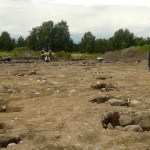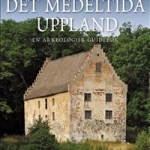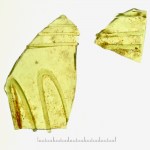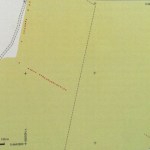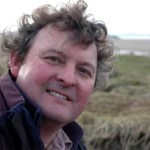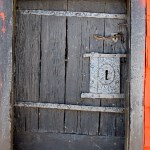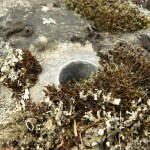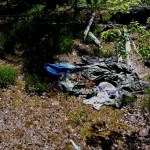

Aardvarchaeology
Dr. Martin Rundkvist is a Swedish archaeologist, journal editor, public speaker, chairman of the Swedish Skeptics Society, atheist, lefty liberal, board gamer, bookworm, and father of two.
This month marks the 50th anniversary of the Rolling Stones's first gig, at the Marquee Club in London. Journalist Hanspeter Kuenzler and Bavarian e-book publishers The eBook People GmbH celebrate the occasion with a massive illustrated two-volume biographical anthology in English on the band. Counting the pages in an e-book is of course difficult. But suffice to say that the first volume, that Aard has received for review, extends to 694 pages on my smartphone, where I read it.
Kuenzler provides the year-by-year narrative backbone of the story and, in a nice touch, for each year lists…
Tomas Romson asked me a good question. Why do archaeological layers form in such a way that older things end up buried below newer ones? The answer is, because people and natural processes deposit dirt on the ground. Using a word borrowed from geology, we call the study of such layers stratigraphy.
Imagine a Neolithic family who build a house on virgin land and live there for some decades. At the end of this phase there are a number of stinky middens and remains of the house on the site. These materials get compacted by microbial activity and mucked around by wildlife, and eventually form a…
Yesterday Jrette, her buddy and I went down to Ströja in Kvillinge outside Norrköping and had a look at the mead-hall excavation I've blogged about. Arkeologikonsult's Björn Hjulström very kindly showed us around. The site will become an Östergötland classic, not only for the 6th century manor hall but also because of its long habitation continuity and for the keen appreciation its excavators have for stratigraphy. I saw hachured plans that would make British urban archaeologists proud.
The excavation is caused by and funded through a planned road widening and railroad improvement which are…
Black Keys – Brothers (2010). Soulful vocals and psychedelic guitars.
Brimstone Solar Radiation Band – Solstice (2005). Melodic Norwegian psych.
David Bowie – Low (1977). Soul rock interleaved with ambient instrumentals.
Howlin' Rain – Magnificent Fiend (2008). Soulful vocals and psychedelic guitars.
Lightships – Electric Cables (2012). Teenage Fanclub bassist goes solo.
Norm Sherman – The Esoteric Order of Sherman (2012). Eclectic musical comedy.
OK Go – Of the Blue Colour of the Sky (2010). Intricate studio pop, Prince falsetto.
Voodoo Trombone Quartet – Eponymous (2005). Ska, rocksteady,…
I have four pleasant things on my desk at the moment:
Finally my first uni job! Humble but very important to me. I've been asked to teach Swedish landscape archaeology to exchange students in English for about 100 hours during the autumn term. Start 4 Sept.
A commission for an encyclopedia article on Viking gaming. Deadline 30 Sept.
A speaking slot at a conference in a Crimean coastal resort during the off-season, to talk about Swedish contacts with that area in the 4th and 5th centuries. Deadline 3 Oct.
A growing book ms. on Bronze Age sacrificial sites. Deadline 31 Dec. 2013.
What about…
Sweden's traditionally divided into 25 landskap provinces. They live on in people's minds despite having been superseded by a new län division in 1634. The boundaries of the landskap go way back into prehistory, and so they don't respect the country's cities much, these generally being much later in origin.
Stockholm is a case in point. Today's urban area is neatly bisected by the boundary between Uppland and Södermanland provinces. Two years ago myself and other Stockholmers got half of our High Medieval itches scratched by a fine archaeological guide book covering Södermanland. Now Johan…
My book Mead-halls of the Eastern Geats appeared last September. On p. 9 I wrote:
Splendid single finds, though never surveyed comprehensively, offer a rough idea of where elite settlements might be sought. But little is known about individual elite settlements in 1st millennium Östergötland. Not one of the Beowulfian mead-halls of this book’s title, being my shorthand for the ostentatious manorial buildings where the Late Iron Age elite lived their lives and played their roles, has been identified in the field. Yet they are easily recognised elsewhere through their architecture and…
This musical style was invented by the Pixies in the mid 80s. Their early work was a main source of inspiration for Curt Cobain of Nirvana. Now Cage the Elephant have recreated the early Pixies style from its blueprints and written a song about Cobain's birthplace in Washington state. I like it!
In other rock 'n' roll news, Fornvännen was just offered a review copy of a book about the Rolling Stones. The journal deals mainly with prehistoric archaeology. I guess Keith Richards has looked like Ötzi for quite some time now, come to think of it.
Major excavations are taking place in Old Uppsala because of railway work. Old Uppsala was a political, religious and mercantile centre from about AD 600 to 1274. In fact it may be termed the central place of the Swedes – tribe and kingdom – during those centuries.
My friend, author Kristina Ekero Eriksson, is the fieldwork's outreach officer and keeps a blog. So far there hasn't been much to report beyond what you might expect on a contract excavation in the region, but now some interesting stuff is popping up. How about some long lines of regularly spaced stone-filled pits? They're in the…
Vår Gård in Saltsjöbaden is a conference venue and training centre whose history illustrates political trends in Sweden over the past century and more.
1892. The Thiel brothers, two of Sweden's wealthiest art patrons, buy a property by the sea in the new fashionable resort of Saltsjöbaden and build two luxurious summer mansions. They name the place Vår Gård, “Our Farmstead”.
1899. The Swedish Cooperative Union is founded.
1924. The Cooperative Union buys Vår Gård and adds a number of buildings to the property to house its new training centre and its art collection.
1932. Sweden's first Labour…
Following up on Saturday's entry on the bleak prospects for many UK archaeology departments, I'd like to share a remark made by a senior colleague a few years back.
All archaeological research covers a certain area of the world. What parts get covered is largely decided by 19-year-old non-archaeologists.
The mechanism is simple. For reasons of convenience and economy, most academic archaeologists study the region where their workplace is located. Regardless of any on-going research, an academic department is dependent on students for its livelihood. Therefore, if students avoid a department,…
Aard has a persistent problem after the migration of Sb to Wordpress. Every day up to a couple of hundred comments spontaneously get "reported" and become invisible. This mostly hits old entries but also some of the newer ones. So don't despair if your comment shows up on the site briefly and then disappears. Nobody's out to get you. I check the list often and re-approve the erroneously hidden comments.
As noted here three years ago, UK contract archaeology is in a deep slump where hundreds of archaeologists have been laid off and a number of excavation units have closed shop. Those experienced and well-connected field archaeologists who got the sack didn't evaporate: many of them are still out there waiting for the job market to improve.
Now, in Current Archaeology #268, Mark Horton (prof. arch. Bristol) warns about "an oncoming archaeological crisis in universities". After an all-time high in the 90s and mid-00s, UK archaeology student admittance numbers have declined steadily:
1996: 704…
With Fornvännen's summer issue on its way from the printers to subscribers, we have published the full contents of last winter's issue on-line (2011:4). This is one of the rare cases where no women have contributed papers, but it's good stuff anyway.
Robin Lindblad on why axes were depicted on Bronze Age rock carvings.
Michael Schneider on the landscape / societal background to Broby place names.
Helmer Gustavson & J.O.H. Swantesson give three newish runic inscriptions with the early futhark the full philological treatment.
Andreas Wiberg & Anders Wikström on geophys mapping of a…
Recently while reading Mats Keyet's 2000 biography of Swedish beat novelist Sture Dahlström, I came across the sad story of the Huskvarna drug. It killed Dahlström's father and many others.
In 1961 Dr. Hjorton's powder was made a prescription drug. This measure was of no great consequence anywhere except in Huskvarna, a small single-company industrial town on Lake Vättern. To Americans, it's probably mostly known for the old Husqvarna motor bike brand. In the mid-1950s the company doctor realised that Dr. Hjorton's powder was not only dependency-forming but in fact caused lethal kidney damage…
Today I celebrate 20 years as a professional archaeologist!
In the spring of 1992 I turned 20, completed my BA, got married and moved out of student accommodation. I was very lucky: I had immediately upon graduation gotten a four-month job on a contract dig for the Arlanda airport bullet train, conducted by the National Heritage Board's Stockholm unit and headed by Marja Mutikainen. To some extent I got the job because I had some professional experience with computers and magazine writing, but more importantly I got it because I had made a friend among the contract archaeologists at a dig…
I had a brief but interesting conversation with a distinguished Chinese art historian the other day. He's my age but has been far more successful than me despite relocating to Sweden. We were talking about science and superstition, because apparently someone had described the Swedish Skeptics that I head to him as “The Swedish Anti-Superstition Society”. Anyway, he told me this (and I paraphrase).
“I'm not sure China is going the right way now with its emphasis on Western science, technology and capitalism. Just look at the environmental degradation and rapid urbanisation. If my country hadn'…
Played the zombie movie boardgame Last Night On Earth and Airlines Europe, both very enjoyable.
Had a party where I couldn't understand what anybody said since they spoke Mandarin, but I was happy being Grillmeister, waitor and dishwasher.
Logged five geocaches, which involved cycling around, climbing a tree and faffing about in the woods north of Älta. Saw the traces of a recent forest fire and found an abandoned camp used by homeless substance abusers (note the toothpaste and beer cans).
And you, Dear Reader?
Here are three podcasts reporting from the Berlin World Skeptics Conference that took place 18-20 May, all featuring yours truly among others.
Skeptikerpodden (in Swedish)
Token Skeptic (in 'Stralian)
Hoaxilla (in German and English)
An unfortunate side effect of the upgrade to Wordpress has been that the feed URLs for this blog have changed, costing me 2/3 of my traffic. This will hopefully be rectified soon, but right now the URLs are:
http://scienceblogs.com/aardvarchaeology/feed/
or
http://scienceblogs.com/aardvarchaeology/feed/atom/
If you don't know what this means, Dear Reader, then you are probably reading the blog by visiting it in your web browser. And if so, you have no problem with this.
Sadly, people who read this blog with feed reading software are unlikely to get this message unless they suddenly one day…

